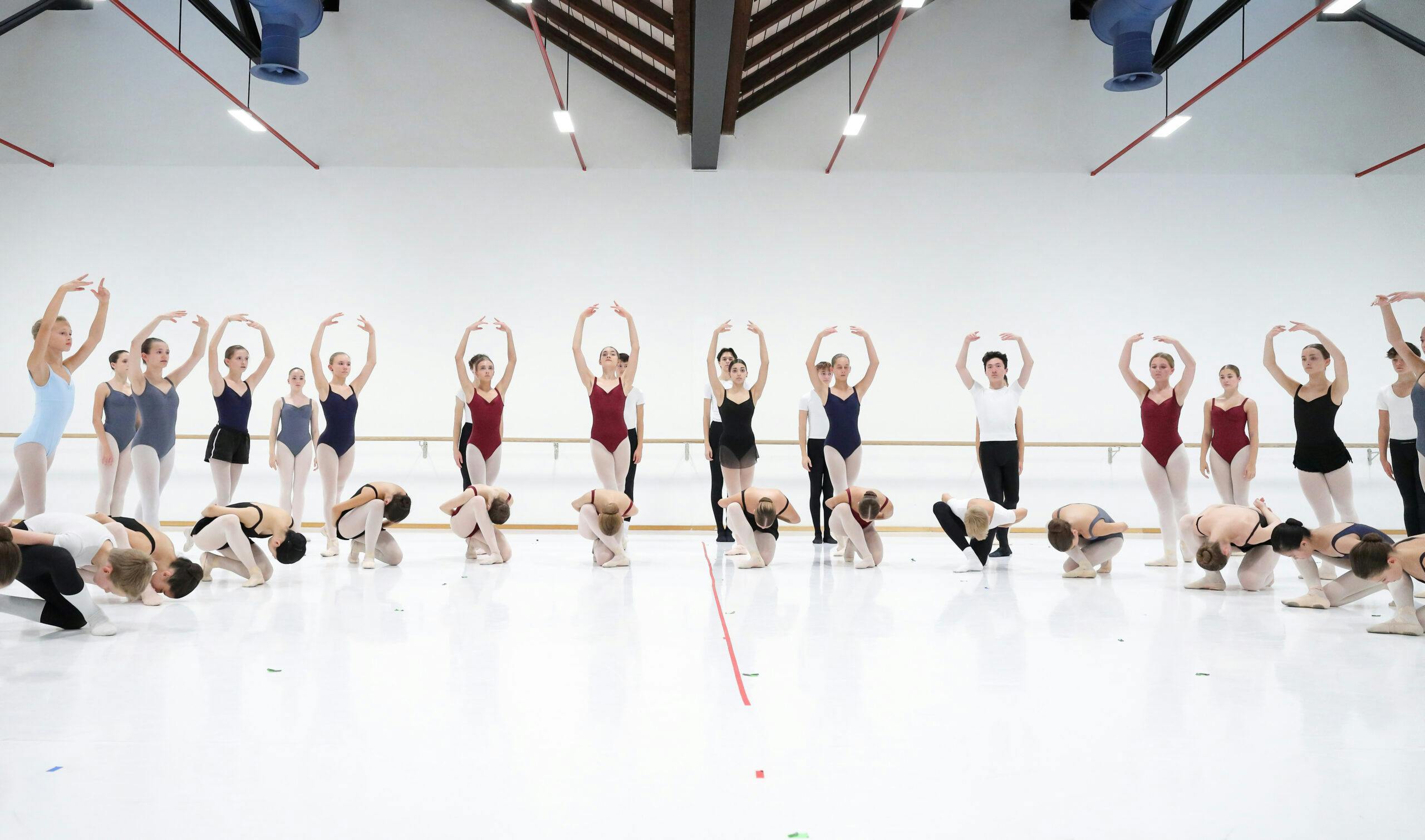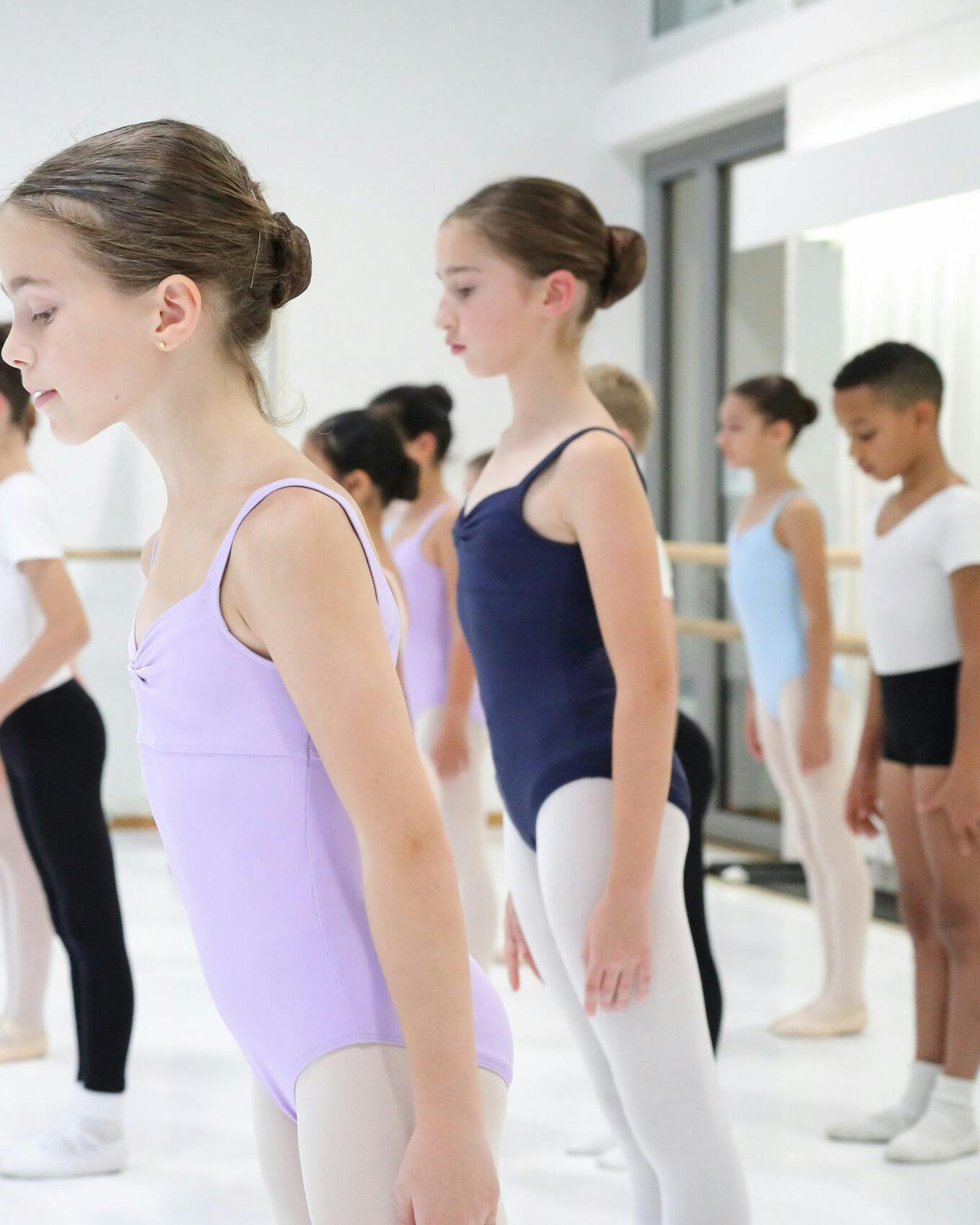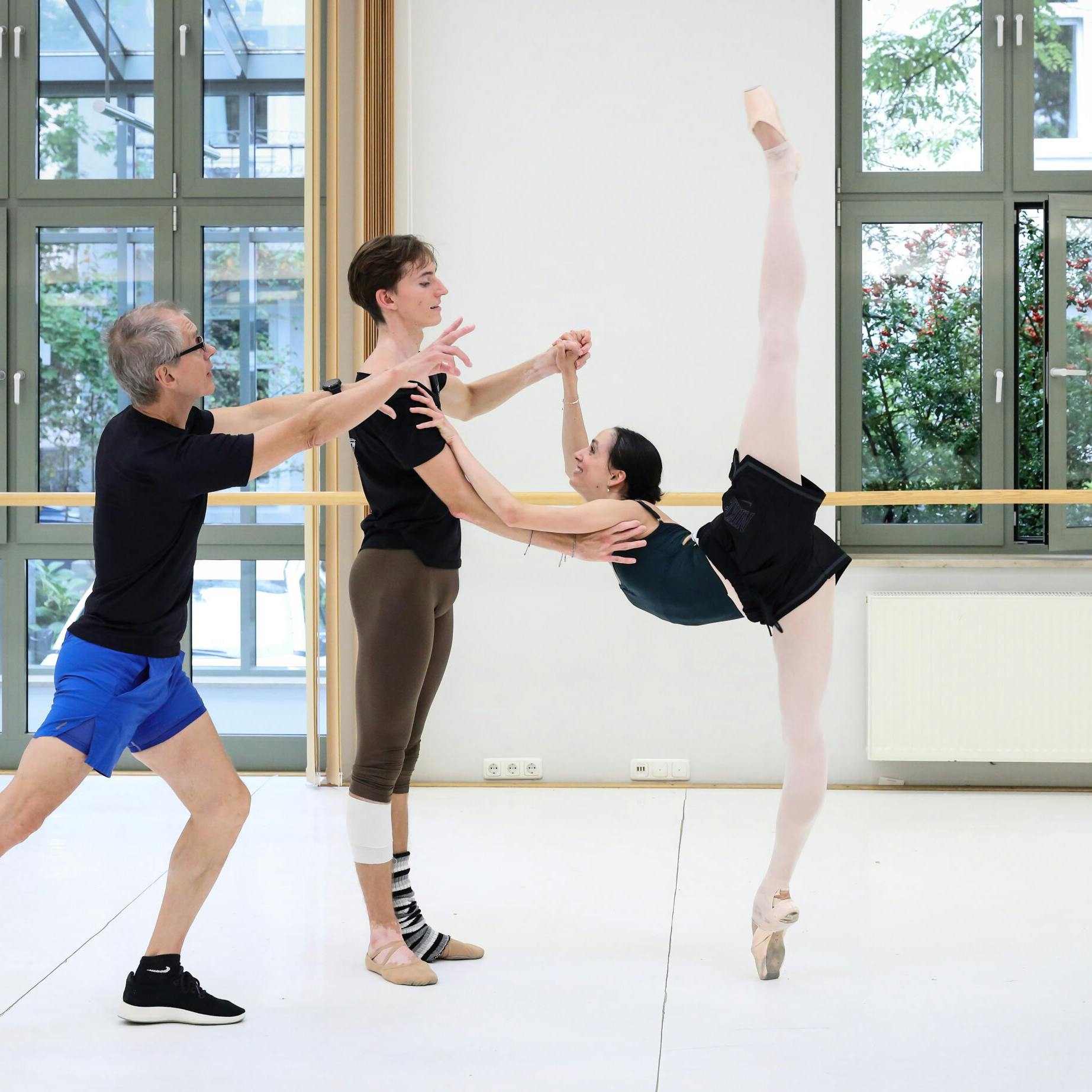Essay
From the Spirit of Hans van Manen – Unisono Returns to the National Theatre
by Anna Beke
When the curtain rises, at first—nothing happens. For four bars, 30 of the 48 children and young people involved in «Unisono» remain motionless in silence, strictly arranged in six rows, arms held close to their bodies, feet parallel in sixth position, the weight slightly shifted forward—the “Hans van Manen pose.” Like the columns of a cathedral, the young dancers form an architectural image of human figures. Gabriela Nicolescu, who has been rehearsing the work for nearly four decades at the Munich Ballet Academy, is certain: “Those four bars without movement have an enormous effect and—when everything aligns—are pure magic.”

While the audience is still marveling at the beginning, the first movement enters the space: a collective breathing and stepping with which «Unisono» opens choreographically—not with grand action, but with contemplative gathering. «Unisono» is a work that grows out of silence and wrestles with it, revealing dance as an exercise “in concentration, cooperation, and musicality.”
From the Studio to the Stage
That Hans van Manen (*1932)—the great “engineer of dance” and minimalist of movement—created «Unisono», a work for children and one of the few in the Dutch master choreographer’s oeuvre of over one hundred pieces, may at first seem surprising. Yet the logic behind it quickly becomes apparent: who but children could approach such an “exercise” with the open-mindedness that van Manen demands—an exercise that is less a pedagogical drill than a choreographic experiment?
True to van Manen’s style, «Unisono» dispenses entirely with embellishment, scenery, or narrative adornment. Black leotards, white tights, simple slippers—nothing distracts from the essence of dance, from its lucid clarity: the body in space, the music, and the shared structure. “There must be nothing decorative. No frills—a choreographer must work without fringes; everything must become completely simple,” van Manen once described as the philosophy of his work.
«Unisono» was created in 1978 at the Royal Conservatory in The Hague—van Manen’s urban artistic home for decades—for no fewer than fifty students of the ballet department. The place of its creation—a training institution, not a professional dance company—already points to the work’s inner intention as an artistic schooling: not only for arms and legs, for port de bras and arabesque, but for mind and attention.
That an “exercise” has become firmly anchored in the programs of renowned academies from Vienna to Hamburg—and for a long time, Munich—and has endured there for nearly half a century may be due not only to the fact that van Manen choreographed it but also to the complex character of this ten-minute jewel: at once strict and free, radically reduced and yet of timeless beauty and grace. The music—Joseph Haydn’s Violin Concerto in C Major and the iconic Air from Johann Sebastian Bach’s Third Orchestral Suite—has also contributed to the lasting success of «Unisono». These are timeless scores—classics of musical art—that in their choreographic adaptation carry nothing pathetic, but in their clarity perfectly complement van Manen’s structure.
Since 1987, «Unisono» has been part of the repertoire of the Munich Ballet Academy—it was last performed there on the stage of the National Theatre in 2011. From the 1970s onward, Konstanze Vernon, founder of the Bayerisches Staatsballett and longtime artistic director of the Ballet Academy, maintained close ties with van Manen and brought several of his signature choreographies to Bavaria. When the two teachers, Gabriela Nicolescu and Maximiliane Hierdeis, now rehearse the work once again with a new generation of dancers in Munich, they do so in the spirit of this decades-long tradition and connection. Both are certain that they are passing on not merely a piece of choreography, but an entire attitude—the spirit and essence of the choreographer himself.
Despite all the care taken to preserve a precious legacy, the current Munich version shows that even such a “historical” work can undergo a living evolution: Originally performed in Munich with an all-girl cast, since the most recent staging at the Ballet School of the Hamburg Ballet—directed by the two Munich pedagogues—boys have also become part of the cast. As Hierdeis emphasizes, their presence not only adds a different kind of energy and stage presence that enriches and modernizes Unisono, but also brings the Munich version closer to the original 1978 production—in which male students had been included from the very beginning. Thus, what might appear as a Munich modernization turns out, in fact, to be a return to authenticity—uniting tradition and innovation at once.

Formal Discipline and Poetic Clarity
The images this training piece creates are not “childlike” in the literal sense. They follow a clear structure and impress with geometric precision that rivals the corps de ballet of a professional company: circles that whirl toward the center like eddies, or diagonals that slice through space and converge at nodal points. “You must be shoulder to shoulder, otherwise the formation won’t work,” the teachers call out during rehearsals in the large hall of the Ballet Academy. A sentence that could almost serve as the motto of the piece: precision here is not mechanical discipline or mere repetition—it is the foundation of community.
The movements themselves may seem deceptively “simple” and plain: walking, turning, port de bras in the neoclassical ballet vocabulary. Yet through precise timing, these simple gestures create wondrous, almost sacred images that linger in memory. The simplicity of the material becomes its very essence—a reduction to what is essential, but never superficial.
For Nicolescu and Hierdeis, the particular challenge of this choreography lies in conveying to the children the beauty of such reduction. “An arabesque at 90 degrees is 90 degrees—and stays 90 degrees,” Hierdeis asserts. “That clarity and meticulous precision must be passed on. And we have to teach them that even a small movement—an arm moving from top to bottom, for example—can carry special meaning.” Nicolescu, her longtime colleague, emphasizes the importance of the imagery the children must create: “If you tell them, ‘Imagine you’re caressing the air,’ the quality of the movement changes. The hands act differently, and the audience perceives that immediately.”
Especially in today’s world, the children’s work on «Unisono» is a true treasure. “It’s about deceleration, awareness, posture—but above all about concentration. For children who experience so much noise and restlessness outside the ballet studio, that’s unfamiliar—but also a great gift.” Every step, no matter how insignificant it may seem, carries responsibility for the whole. Individual brilliance is not the focus here, but the collective presence and shared aura. “It’s not enough to learn a tendu or a jeté—you must also learn to be musical, to work together, and to focus when it’s required. It’s no use if that only happens after the performance or later in the evening. It must be practiced,” says Hierdeis with conviction.
Alongside the emphasis on community, she also recognizes in this choreographic work a strong focus on self-awareness: “You have to block out everything else. Everything has its rhythm, its musicality. The framework of the movement is clearly defined—within that alone one moves. That’s invaluable today.”
In doing so, the children experience a sense of joy that goes beyond technical precision. In a time marked by individualism, they discover the power of the group, the beauty of synchrony, the calm of focused breathing—and, ultimately, a sense of identification with the shared movement. “It has something meditative about it, and that feels incredibly good in our time”—«Unisono» as a counterpoint and antidote to isolation and constant self-presentation.

Human Connections
“Dance is about dance,” is one of van Manen’s famous mottos. Yet «Unisono» contradicts this as openly as many of his other works, which may not follow linear storytelling but still convey narratives in their own way. For here, it is ultimately about relationships between people—about human communication within the collective. “«Unisono» is ultimately about cooperation, about how people find each other,” both teachers agree.
When, at the end of the first part of «Unisono», all the children stand tightly clustered together at the center of the stage—shoulder to shoulder—what emerges is not chaos, but an image of unity that radiates out into the audience. “It’s as if, with the first note, you put on the invisible but deeply felt ‘Hans van Manen cloak,’ and with the last note, you take it off again,” Nicolescu describes. “In those ten minutes, the children are transformed.”
«Unisono»—with its sacred aura—resembles a cathedral built of bodies: constructed for a fleeting moment by those who are only just beginning to learn the art of dance and who grow beyond themselves with every rehearsal. Watching it, one understands how much greatness can lie in simplicity—and how much wisdom in Hans van Manen’s saying: “Everything must become completely simple.”








